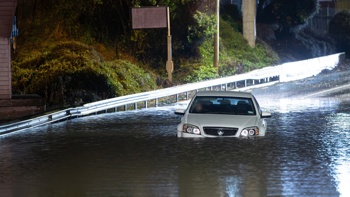Concerned residents who rang Hawke’s Bay Civil Defence and Emergency Management in the days before Cyclone Gabrielle flooded the region were told they were “over-reacting”, or that plans were well in hand.
But an independent review by Mike Bush into the response into the February 14 disaster that killed eight and left thousands displaced has found the organisation was anything but.
In fact, the “severity, speed and scale” of the disaster simply “overwhelmed the officials” tasked with disaster response in the region.
Bush told the Hawke’s Bay Civil Defence Emergency Management Joint Committee in Napier on Monday that New Zealand’s emergency management system is not fit for purpose, and “sets up good people to fail”.
The former police commissioner said the review was not a “blame apportioning exercise” but his 117-page report contains nine tier one recommendations for officials and a further 66 tier two recommendations.
Bush spoke to the Hawke’s Bay Civil Defence Emergency Management Joint Committee in Napier on Monday, ahead of the review being officially received.
He said the exercise was “very much how do we understand the systems, and what worked well and how do we improve for the future.”
It included a lack of “situational awareness”, yet wasn’t just a regional issue.
“The national emergency management system is not [fit] for purpose. ”It sets up good people to fail.
“What did not work so well was it was absolutely clear that the severity, speed and scale of the disaster quite simply overwhelmed the officials involved in the response.
- 'It's depressing': Gabrielle still hammering kiwifruit growers
- Why this student wants to future-proof farms against natural disasters
- Police response during Cyclone Gabrielle in Central Hawke's Bay commended
- One year on, we remember them: The 11 people who died in Cyclone Gabrielle
“We need more clarity around how we bring all these agencies [involved in emergency response] together. Without that you don’t get the co-ordinated response that our communities deserve.”
‘Confident’ they had made appropriate preparations
The report said authorities in Hawke’s Bay “felt confident” that they had made appropriate preparations. Public warnings and information about how to prepare had been posted on Facebook.
Emergency management personnel, senior leaders, mayors and partner agencies across the region had met to plan their response.
“The accountable members of the Hawke’s Bay Civil Defence and Emergency Management Group Joint Committee had asked probing questions and been given assurances of readiness by their emergency management teams.”
“Orange weather warnings from Met Service applied to the region. Hawke’s Bay Regional Council modellers felt that, while the forecast 300-400mm of rain would test flood protection and drainage schemes, river flows were unlikely to rise beyond the 1 in 50 and 1 in a 100-year return periods on which their design had been based.”
“Even when the weather warning moved to Red on Monday, emergency management staff were reassured that Met Service predictions of rainfall quantums remained unchanged.
“And when some members of the public, including mana whenua with deep knowledge of the behaviour of the region’s waterways, phoned emergency management authorities with concerns about observable river levels, forestry slash or river maintenance, they were told they were ‘overreacting’ or that plans were well in hand.
“However, during the late evening of Monday 13th February, 2023 and the early hours of Tuesday 14th, rain and winds intensified in the Hawke’s Bay ranges and across the Heretaunga flood plains to unprecedented levels.”
“Drainage systems were overtaken, stopbanks were breached or compromised. River flow telemetry failed as electrical substations were damaged, and some rain gauges stopped working for a period, while others were subject to such high winds that they underreported rainfall levels.
“The combined effects of silt from landslides, high rainfall, and forestry byproducts led to rivers breaching their banks, with silt covering crops and filling homes.
“Critical infrastructure -roads, electricity, fibre, bridges, businesses - was inundated, damaged or destroyed. During this critical period, lives were lost, livelihoods ruined, communities were cut off and thousands of people across the region were traumatised, required rescue and were displaced.“
‘Simply overwhelmed’
Bush said communications failures, lack of data and the speed, severity and extent of this event overwhelmed staff in the GECC.
“They, and their partners in the other territorial authority Emergency Operations Centres (EOCs) did some brave and innovative things.
“They also had significant blind spots and made some mistakes. But above all, they were simply overwhelmed.”
Cyclone Gabrielle tore through Hawke’s Bay late on February 13 and early on February 14 last year, killing eight people and destroying or damaging over 1000 homes. One person remains missing.
Many communities were cut off following the flooding with significant destruction caused to the region’s roads and bridges.

The highly-anticipated review into Hawke's Bay Civil Defence's response to Cyclone Gabrielle has been released. Photo / NZME
Some residents did not receive a Civil Defence warning to evacuate until it was far too late - including cases in Esk Valley where residents received an alert while on the roof or huddled in their ceiling.
Bush was appointed to head the independent review, which began in August.
The Hawke’s Bay CDEM Group Joint Committee commissioned that review, and the committee is made up of the region’s four mayors plus the regional council chairwoman.
The scope of the review was to assess the operational performance of Hawke’s Bay CDEM Group’s immediate response to the cyclone, with a particular emphasis on the systems and processes, and roles and responsibilities of group members and partners.
It was revealed last year that Hawke’s Bay Civil Defence Emergency Management Group controller Ian Macdonald was on leave for a tramping trip in the South Island when Cyclone Gabrielle hit the region.
Macdonald was out of mobile coverage in the days before the cyclone, and had no contact with other Civil Defence workers from February 9 until late on February 13.
More to come.
Take your Radio, Podcasts and Music with you









